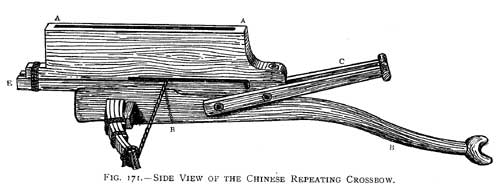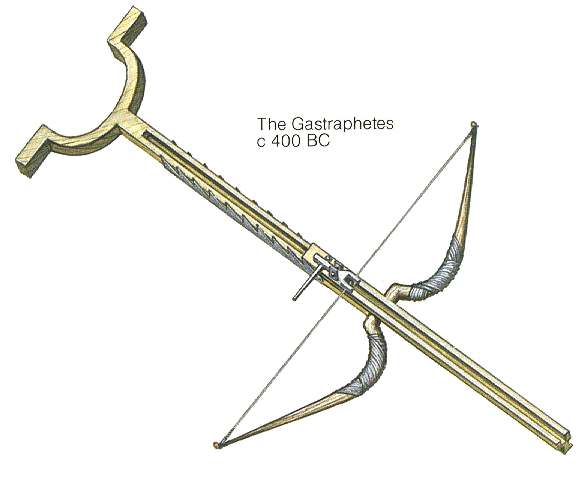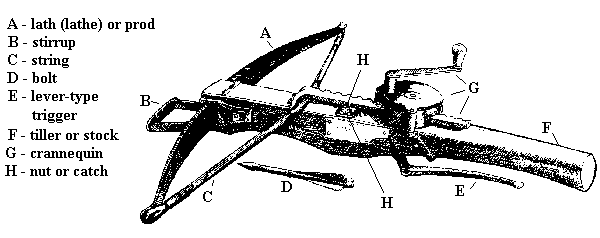China
The history of the crossbow dates back to 4 th century BC in Ancient China. Early finds of crossbows were discovered tomb at Saobatang, Huan dated to 4th centuru BC. Repeating crossbows were discovered in tomb at Quinjiazui, Hubei dated to 4th century BC. Repeating crossbow is first mentioned in the Record of Three Kingdoms.
The crossbow is is the most frequently weapon mentioned in the ancient chinese sources. It was wiedly used by army of Hun dinasty (202 BC-220 AD). Crossbow was often given credit for the Han army`s superiority over its enemy.
Chine also invented muliple-bolt crossbow. Lian Nu was generic term for any type of crossbow which fired multiple bolts at the same time. This was huge crossbow that was mainly mounted on wheels.
Chu-ko-nu was popular hand held repeating crossbow in China. Invented by Chu Ko Liang during later Han period. It was for high "rate of" against massed troops at ranges not exceeding 50-75 yards.
Chinese repeating crossbow:
Greece
In Grece in 399 BC was invented a mechanical arrow firing catapult called katapeltikon. This weapon was later used in battles. In 3rd century BC engineer Ctesibius invented hand held crossbow gastraphetes (belly shooter). Gastraphetes was using composite bow and was cocked by resting the stomach in a concavity on the rear of the stock and presing down. It was a big weapon.
Gastraphetes:
Roman empire
Romans was using huge siege machine that was made by the same principle as a crossbow. In Roman times crossbow was named arcubalista. Romans was using ordinary small hand held crossbows arcubalista. Vegetius (4th century) write about it in his treties on military art. Manuballista hand held crossbow was also used by Romans.
Roman arcubalista:
Manuballista:
srijeda, 28. ožujka 2012.
ponedjeljak, 26. ožujka 2012.
Crossbow terminology
Crossbow is called by many names most of wich is derived by term Balista. Balista was great siege engine resembling a crossbow, though much larger in size.
Arbalist - Latin language term for crossbow.
Arbalète - Term for crossbow in France and Belgium.
Armbrust - German language term for crossbow.
Arrow - Projectile consisting of shaft with pointed head (arrowhead), vanes for flight-stabilazing and nock. Term arrow is used by modern crossbow manufactureres.
Back of bow - The side of bow facing target.
Barreled crossbow - Crossbow having turbular barrel; used to shoot balls; also called slurbow.
Bastard string - String to brace a crossbow for installation the bowstring.
Belly of bow - The side of bow facing shooter.
Bolt - Short heavy projectile for crossbow; several times heavier than a arrow.
Bowstring - String used on crossbow to transfe energy fros bow to projectile.
Braced height - Distance between braced bowstring and belly side of riser, measured from the bowstring's centre.
Broadhead - Type of arrowhead, used mainly for hunting.
Bullet crossbow - Crossbow designed to shoot bullets.
Butt - The rearmost portion of the tiller.
Center shot - Crossbow lath designed so that the projectile passes through its center, centre-shot crossbows often have two separate limbs.
Cock - To draw bowstring from braced position to latched position.
Cocking lugs - Metal pins on crossbow for anchoring bending lever, cranequin or goat's foot.
Cocking peg - Peg required to set some crossbow trigger mechanisms prior to cocking.
Cocking ring - Metal ring bound to the front of the lath to anchor bending lever.
Cockscombing - Method of serving sometimes used on loops of crossbow bowstrings.
Cord and pulley - Cocking aid consisting of cord with ends attached to crossbow butt and user's belt running through a pulley attached to bowstring.
Cranequin - Cocking device using rack and pinion.
Crossbow - Archery weapon consisting of a bow mounted to a rigid stock.
Dry fire - To release cocked bowstring without projectile.
Endcap - protective cap to protect rear of bolt.
Goats foot - Two-piece hinged cocking lever designed to pull bowstring from behind.
Latch - Mechanism in the tiller of a crossbow to hold the bowstring in the cocked position, which also releases the bowstring when the trigger is released.
Lath - Bow portion of a crossbow storing motive energy for propelling projectile.
Limb - Portion o lath left or right from center.
Manubalista - Smaller form of ballista.
Nock - Groove on the back of a bolt or arrow into which the bow string is placed.
Nose - Forward end of crossbow.
Power stroke - Distance between braced and cocked string positions.
Prod - Bow portion of crossbow.
Quiver - Container for carrying arrows or bolts.
Riser - Non-bending centre of bow.
Safety - Device used to prevent crossbow from shooting unintentionally.
Spanning - Physical act of cocking a crossbow.
Stirrup - Device for holding the crossbow with feet while cocking.
Stock (or tiller) - Portion of the crossbow to which all other components are attached and by which it is held.
Track - Grooved portion of the crossbow between the bow and latch where the projectile rides.
Windlass - Crossbow cocking device using a system of pulleys and cords.
Medieval crossbow parts:
Modern compound crossbow parts:
Arbalist - Latin language term for crossbow.
Arbalète - Term for crossbow in France and Belgium.
Armbrust - German language term for crossbow.
Arrow - Projectile consisting of shaft with pointed head (arrowhead), vanes for flight-stabilazing and nock. Term arrow is used by modern crossbow manufactureres.
Back of bow - The side of bow facing target.
Barreled crossbow - Crossbow having turbular barrel; used to shoot balls; also called slurbow.
Bastard string - String to brace a crossbow for installation the bowstring.
Belly of bow - The side of bow facing shooter.
Bolt - Short heavy projectile for crossbow; several times heavier than a arrow.
Bowstring - String used on crossbow to transfe energy fros bow to projectile.
Braced height - Distance between braced bowstring and belly side of riser, measured from the bowstring's centre.
Broadhead - Type of arrowhead, used mainly for hunting.
Bullet crossbow - Crossbow designed to shoot bullets.
Butt - The rearmost portion of the tiller.
Center shot - Crossbow lath designed so that the projectile passes through its center, centre-shot crossbows often have two separate limbs.
Cock - To draw bowstring from braced position to latched position.
Cocking lugs - Metal pins on crossbow for anchoring bending lever, cranequin or goat's foot.
Cocking peg - Peg required to set some crossbow trigger mechanisms prior to cocking.
Cocking ring - Metal ring bound to the front of the lath to anchor bending lever.
Cockscombing - Method of serving sometimes used on loops of crossbow bowstrings.
Cord and pulley - Cocking aid consisting of cord with ends attached to crossbow butt and user's belt running through a pulley attached to bowstring.
Cranequin - Cocking device using rack and pinion.
Crossbow - Archery weapon consisting of a bow mounted to a rigid stock.
Dry fire - To release cocked bowstring without projectile.
Endcap - protective cap to protect rear of bolt.
Goats foot - Two-piece hinged cocking lever designed to pull bowstring from behind.
Latch - Mechanism in the tiller of a crossbow to hold the bowstring in the cocked position, which also releases the bowstring when the trigger is released.
Lath - Bow portion of a crossbow storing motive energy for propelling projectile.
Limb - Portion o lath left or right from center.
Manubalista - Smaller form of ballista.
Nock - Groove on the back of a bolt or arrow into which the bow string is placed.
Nose - Forward end of crossbow.
Power stroke - Distance between braced and cocked string positions.
Prod - Bow portion of crossbow.
Quiver - Container for carrying arrows or bolts.
Riser - Non-bending centre of bow.
Safety - Device used to prevent crossbow from shooting unintentionally.
Spanning - Physical act of cocking a crossbow.
Stirrup - Device for holding the crossbow with feet while cocking.
Stock (or tiller) - Portion of the crossbow to which all other components are attached and by which it is held.
Track - Grooved portion of the crossbow between the bow and latch where the projectile rides.
Windlass - Crossbow cocking device using a system of pulleys and cords.
Medieval crossbow parts:
Modern compound crossbow parts:
nedjelja, 11. ožujka 2012.
Crossbow basic
Crossbow is a weapon consisting of stock called tiller, and horizontaly mounted bow that shoots projectiles, called bolts. It is very importent historical weapon, and today weapon.
All elements of crossbow is: bow, stock (tiller), bow string, trigger, cylindrical pawn (nut) to retain the string, stirrup.
Photos of crossbows (first - medieval, second - modern):
All elements of crossbow is: bow, stock (tiller), bow string, trigger, cylindrical pawn (nut) to retain the string, stirrup.
Photos of crossbows (first - medieval, second - modern):
Pretplati se na:
Postovi (Atom)







